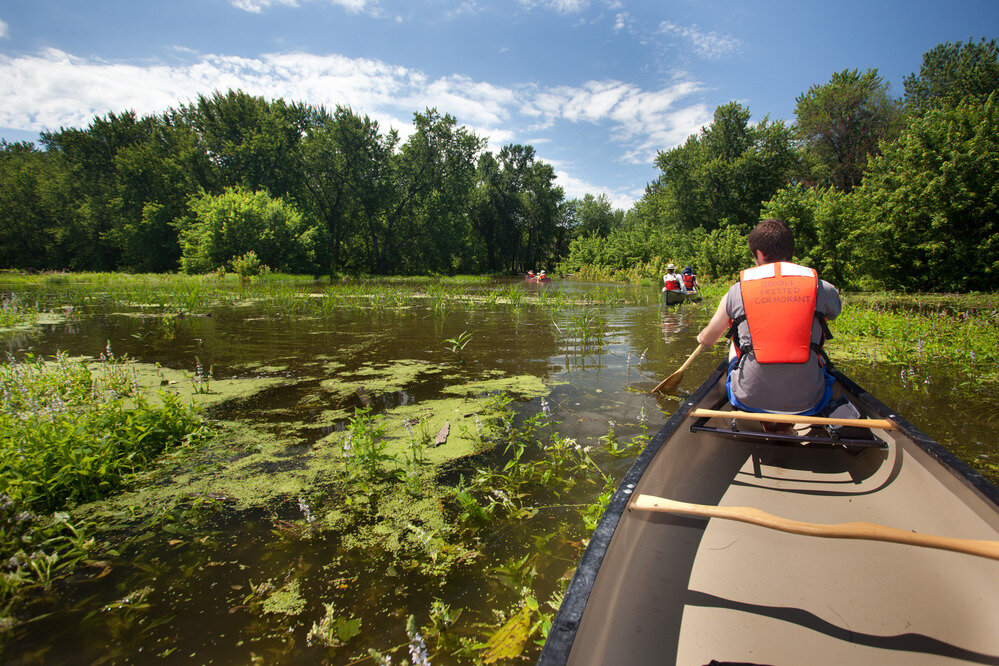Cottonwood Trees: A Water Perspective
Cory Mohn, Park Ranger, Mississippi National River and Recreation Area
Walking along the Mississippi River, it is hard to miss the cottonwood trees towering above the riverbank. We notice them for the things that we can see; the shade they cast on us, the animals that call them home, and the display of yellow color before the leaves fall. There are other aspects of the cottonwood that are harder to appreciate though because they are invisible or take time to notice. This includes the cottonwood tree’s connection to the water cycle. I discussed this briefly as part of a recent Coffee with a Ranger video, but I wanted to take a moment to go into some more detail on the cottonwood’s use of water.
First off, out of all the trees that grow in our park, why did I pick the cottonwood to talk about? The cottonwood tree is the fastest growing native tree in North America. Only some of the water in a plant becomes growth, 1-10% at most, so plants that grow faster also use a lot more water. A single cottonwood tree can consume anywhere between 50 and 200 gallons of water each day. In comparison, an oak tree can consume up to 50 gallons. Cottonwood trees also have a tendency to grow close to the river where they have access to plenty of water, while trees that are further away tend to be limited to the amount of water they get from rain. This means the cottonwood tree has one of the strongest connections to the water cycle out of all the plants in our park.
Cottonwood trees, like all plants, move water through a process called transpiration. This is the evaporation of water from tiny pores in the leaves of the tree called stomata. As the water evaporates it pulls more water up through the tree carrying nutrients along with it. In fact, without transpiration a cottonwood tree couldn’t grow to be 36 to 190 feet tall since capillary action alone cannot move water any higher than 32 feet. Transpiration also cools the leaves down as the evaporating water removes excess heat from the sun that would otherwise damage the leaves. This process of transpiration is completely invisible to the eye and without the aid of a container to catch and condense the water vapor leaving the leaves we cannot see it. We do feel the benefits of this process though. Globally plants are responsible for 10% of the water vapor in the atmosphere, but locally that can be much higher. It takes a lot more energy to heat water vapor up compared to dry air, so locations that have humidity released by plants tend to be cooler. It’s uncommon for us to have temperatures above 90°F in Minnesota, with temperatures above 100°F being rare, but in desert regions with fewer leafy plants it’s common to go above 100°F and even as high as 120°F.
An understanding of what cottonwood trees use water for is only part of the picture though. To get the full picture needed to appreciate the cottonwood’s use of water we need to know how much water all of the cottonwood trees in our park use, which then allows us to compare that water use to our own. To estimate how much water cottonwoods use, we need to estimate how many trees we have and where those trees are found. With help from Adam Muilenburg and our forestry management team I was able to estimate that we have a total of 16,440 trees, with 10,770 of those growing in wetland habitats and 5,670 trees in upland habitats. Using this I could then estimate the amount of water these trees use in a year to be 407-549 million gallons a year. The lower value would be for a drier year with the higher value being a wet year. To compare this to our water use, St. Paul pumps around 11 billion gallons of water out of the Mississippi each year. In a wet year the cottonwood trees are using 5% of that amount, but when you consider the trees only use water during the growing season, the actual rate at which they use water is equal to 10% of the rate St. Paul pumps water out of the Mississippi.
So the next time you are walking beneath the cottonwood trees by the Mississippi River, remember that they are not just idly standing around waiting for an eagle to perch on them. These trees are actively moving large amounts of water from the ground into the sky. That movement of water not only keeps the tree alive but also helps keep our local climate from reaching the extreme temperatures found in regions with fewer plants. In their own way, the cottonwood trees are welcoming us out to explore the banks of the Mississippi River.
Learn about our Plant for the Future project and how Mississippi Park Connection, together with the National Park Service, spent two years studying to find the best way to plant cottonwood trees in the Mississippi River floodplain!



